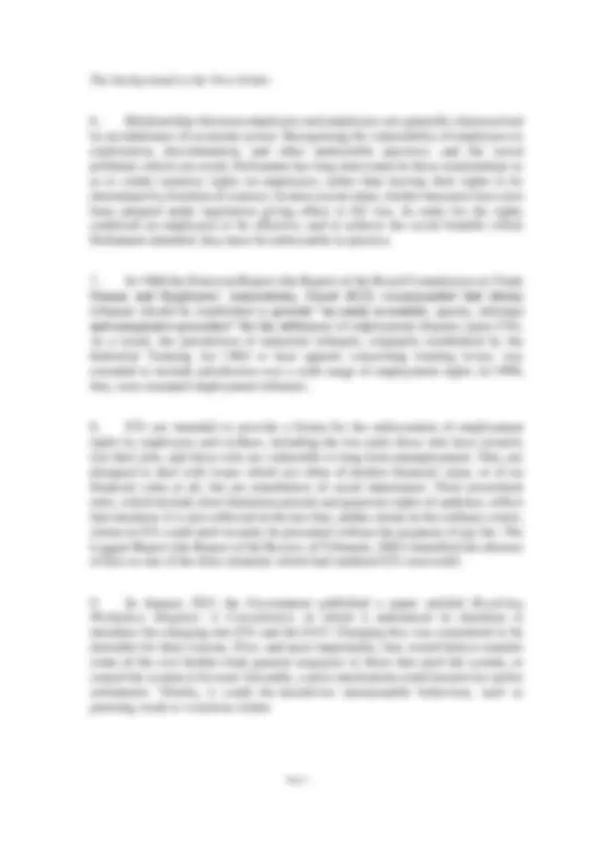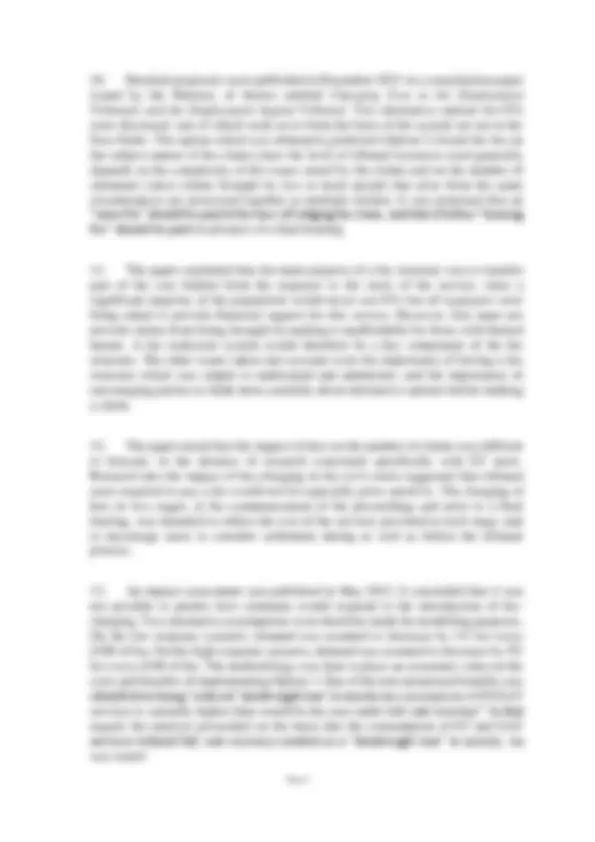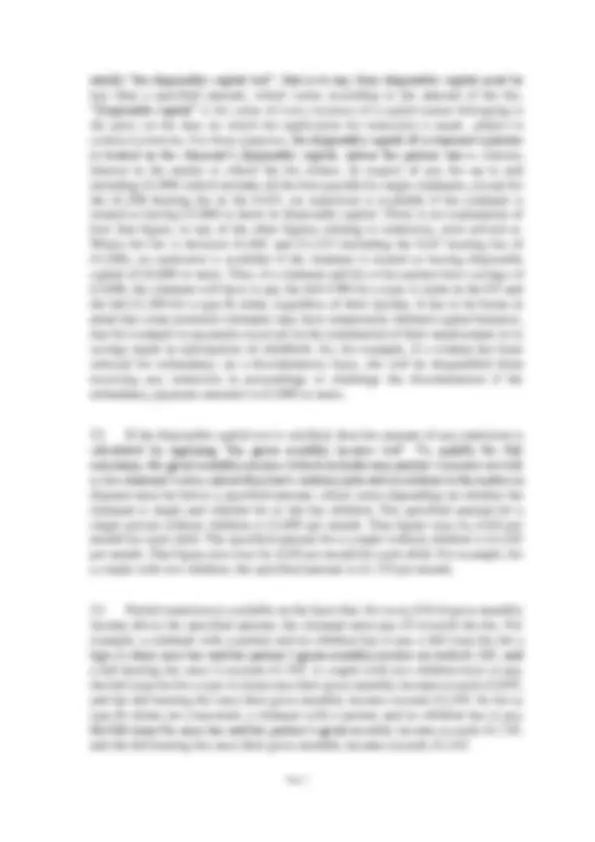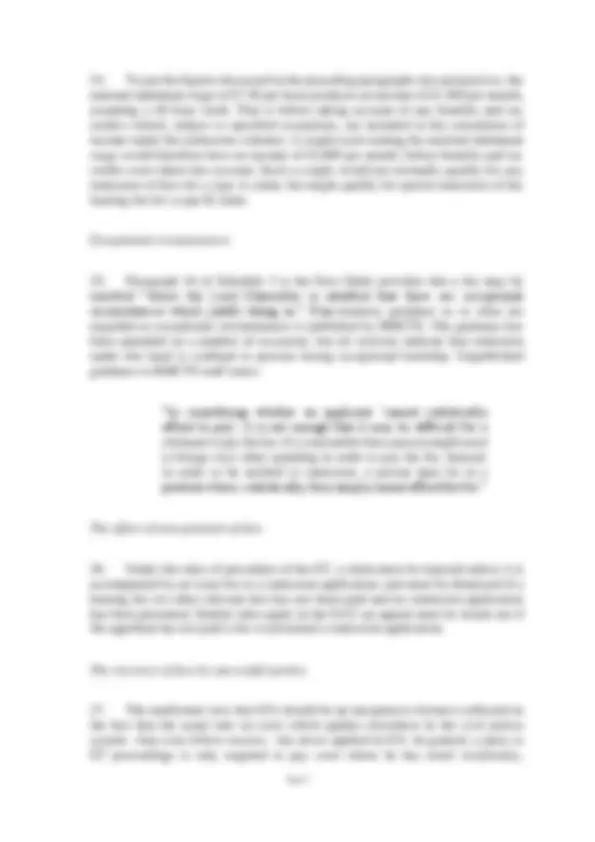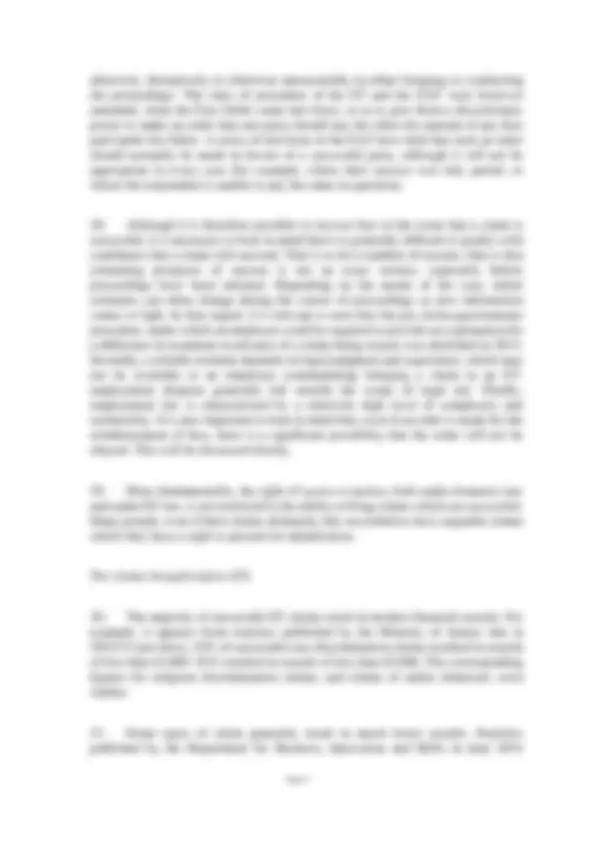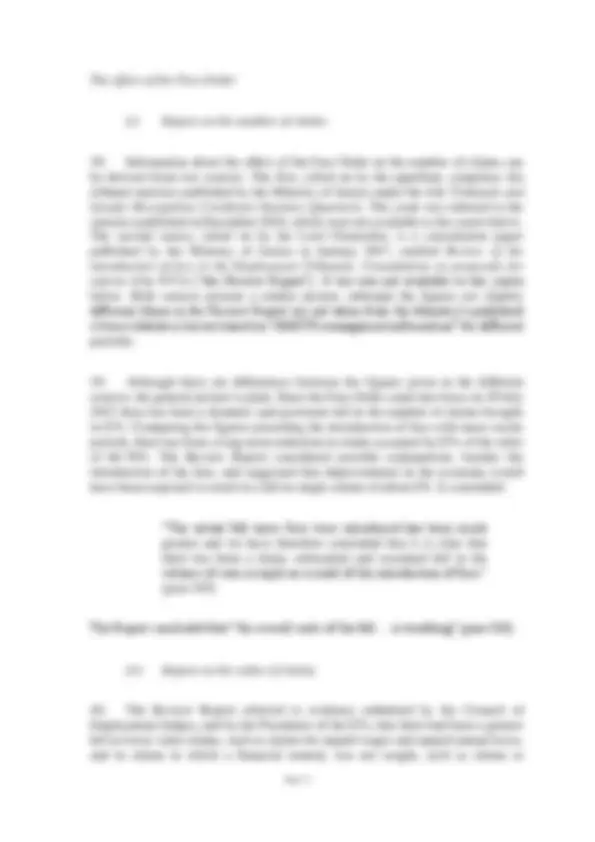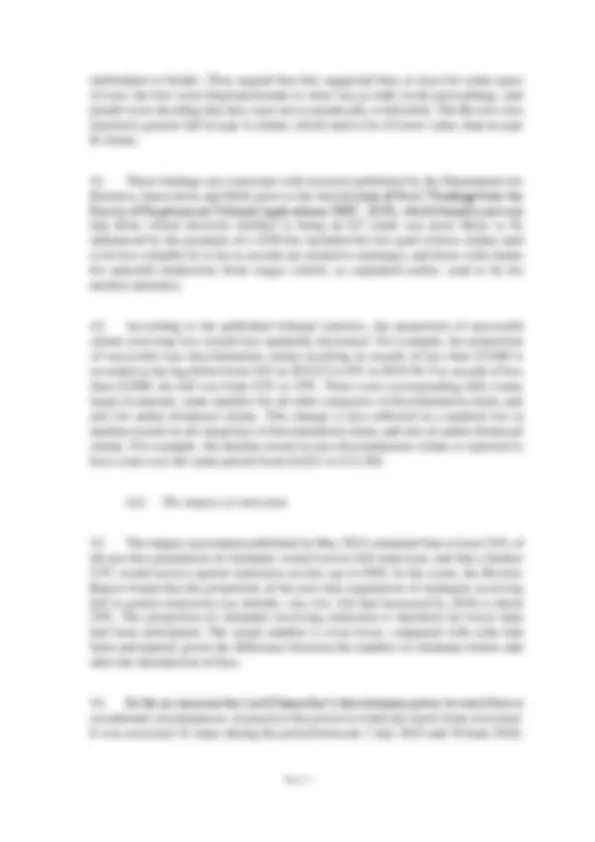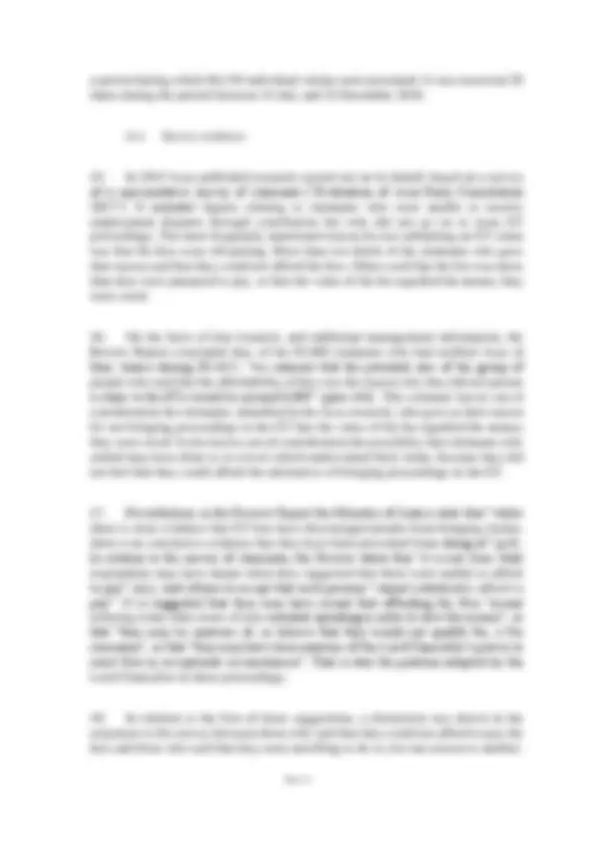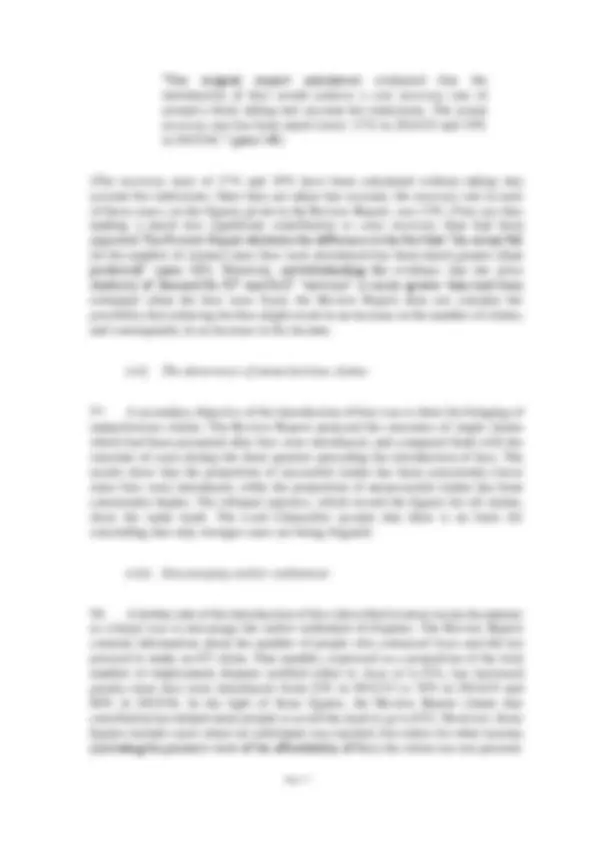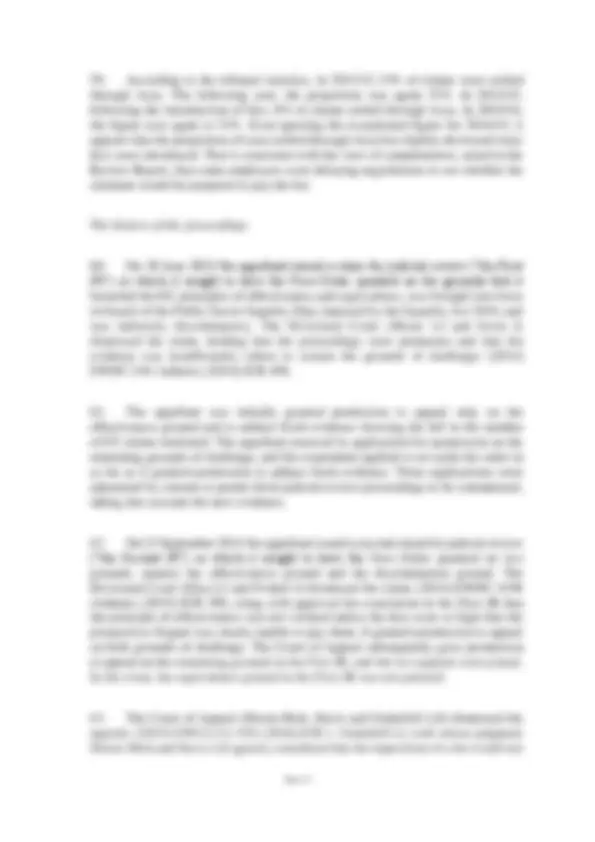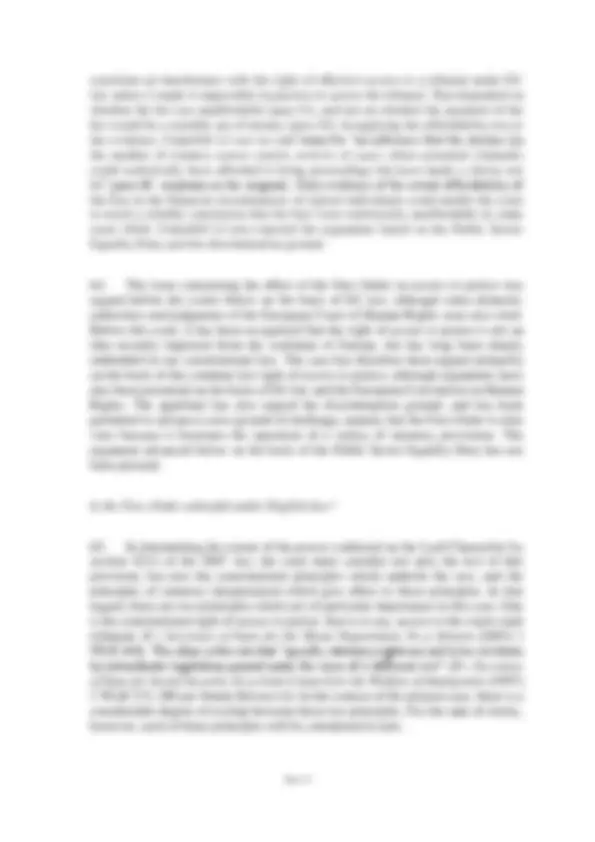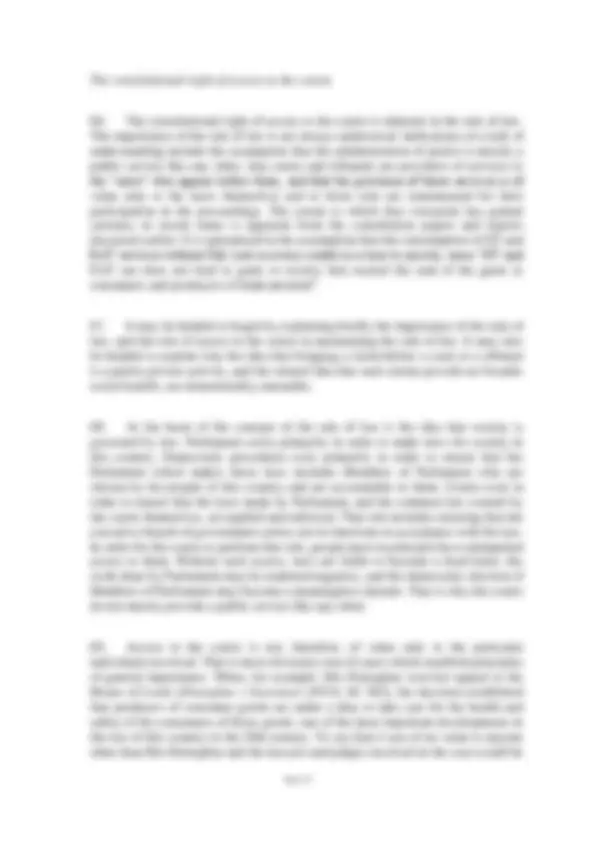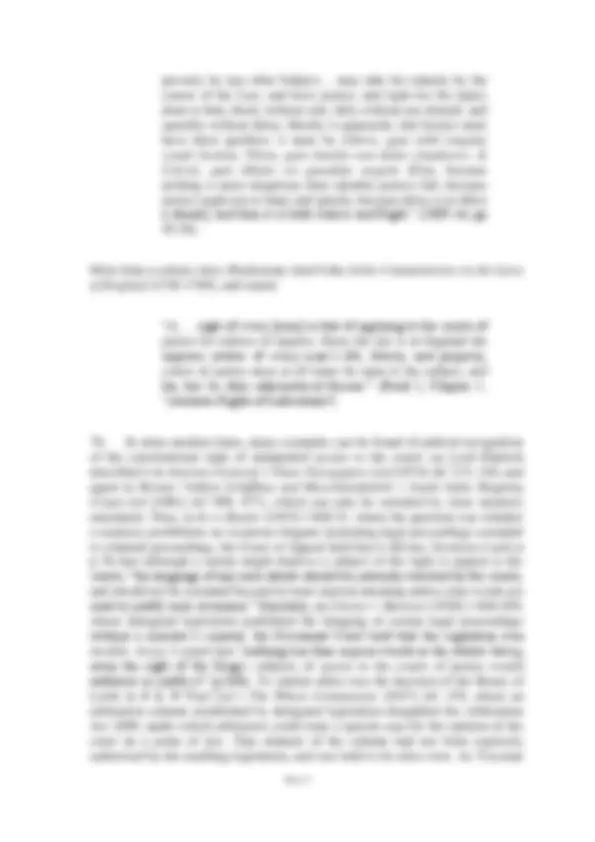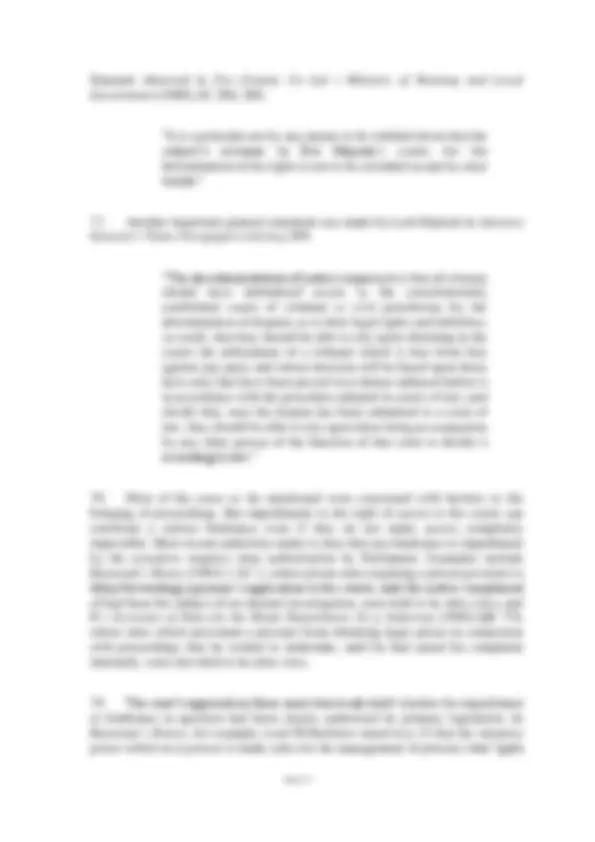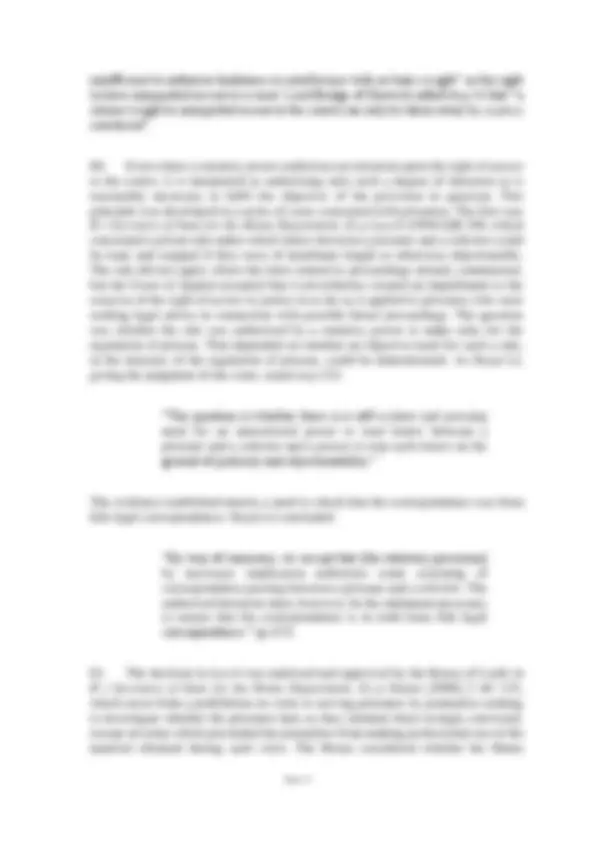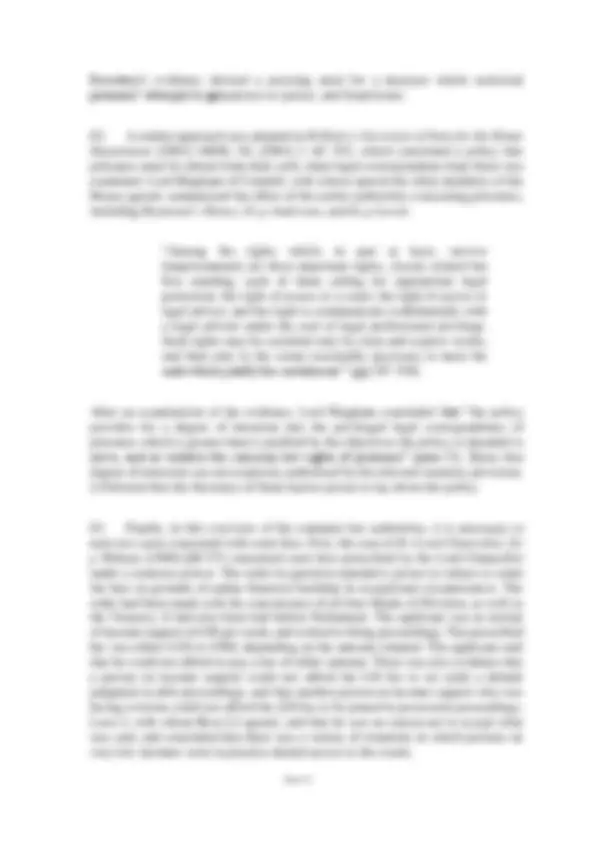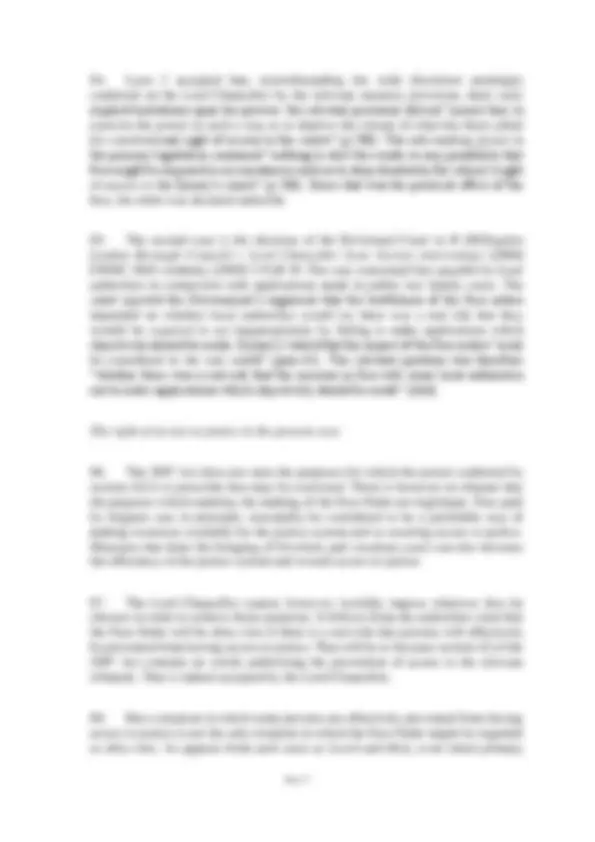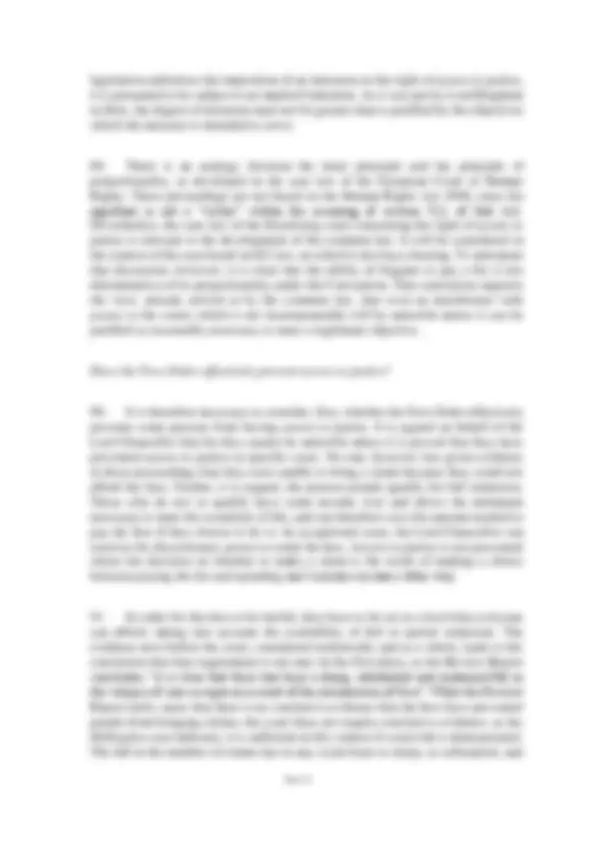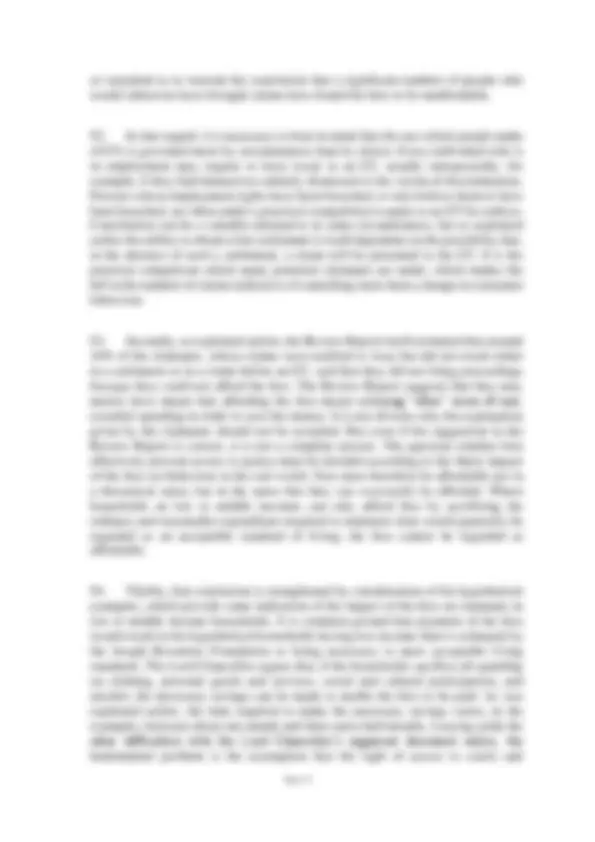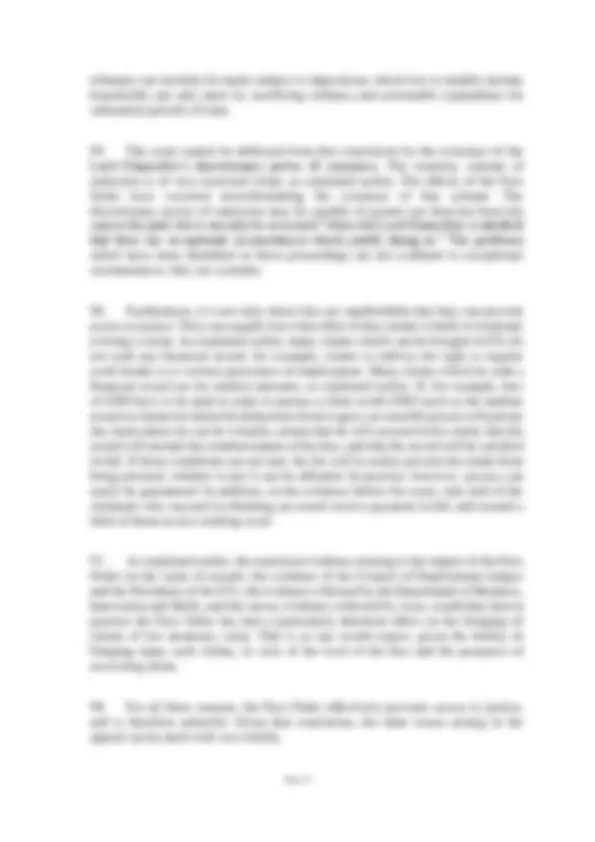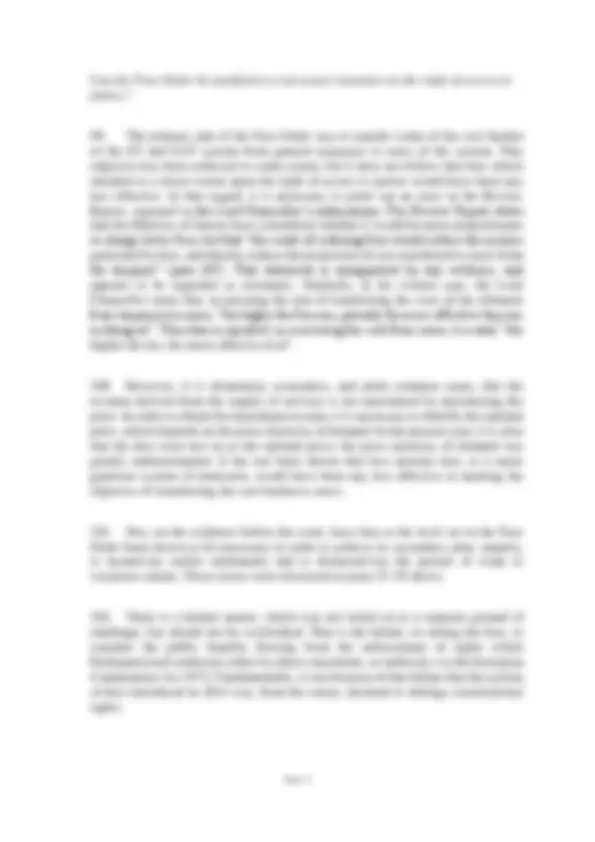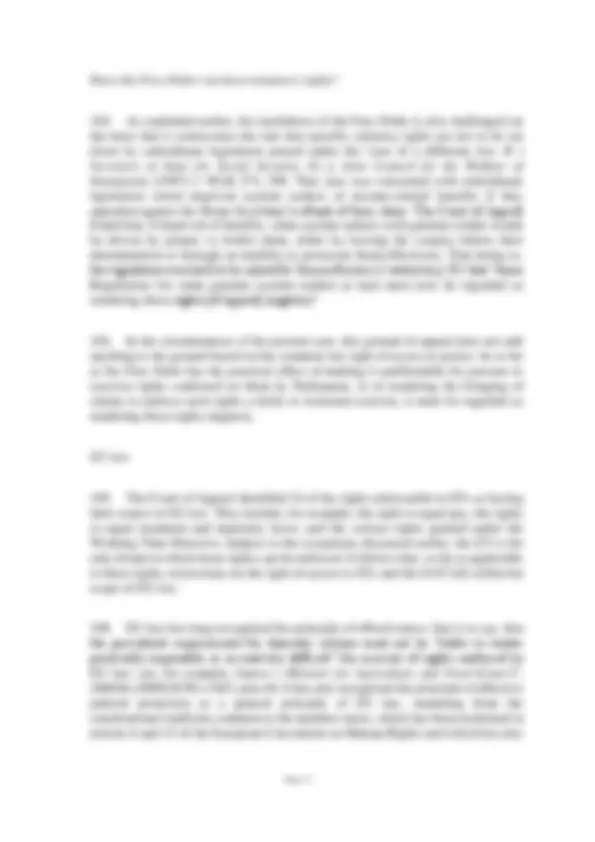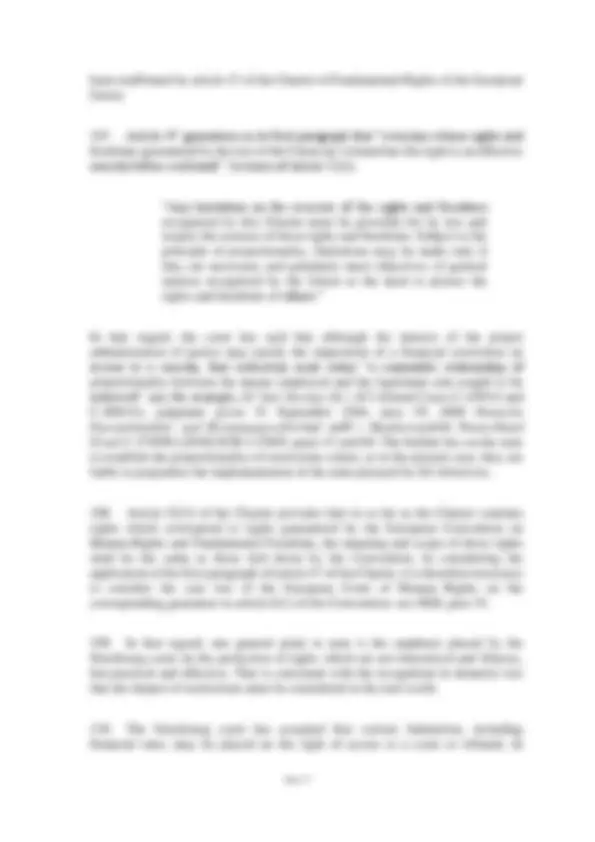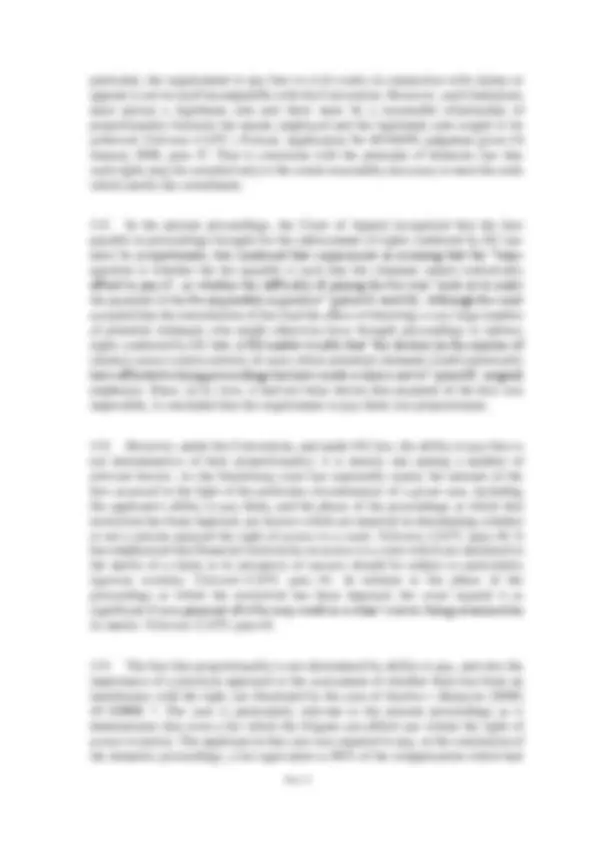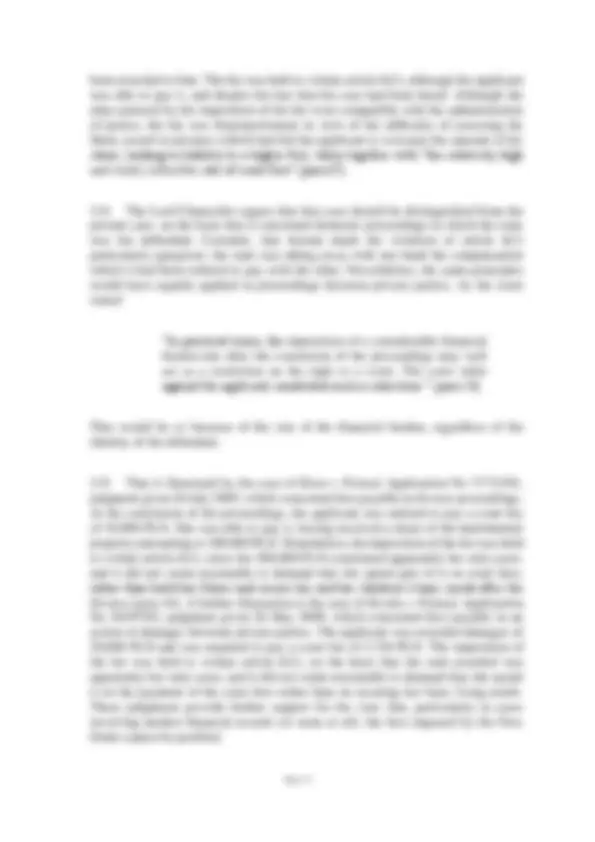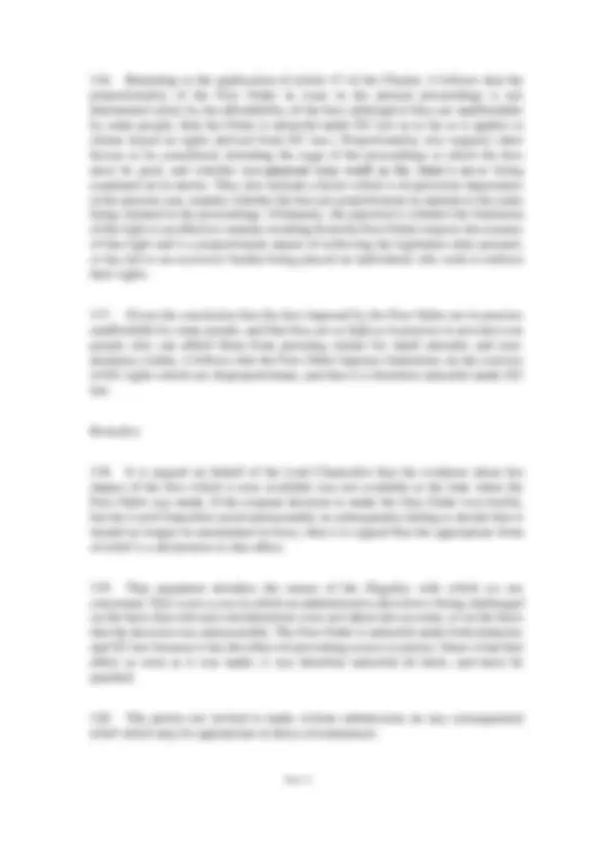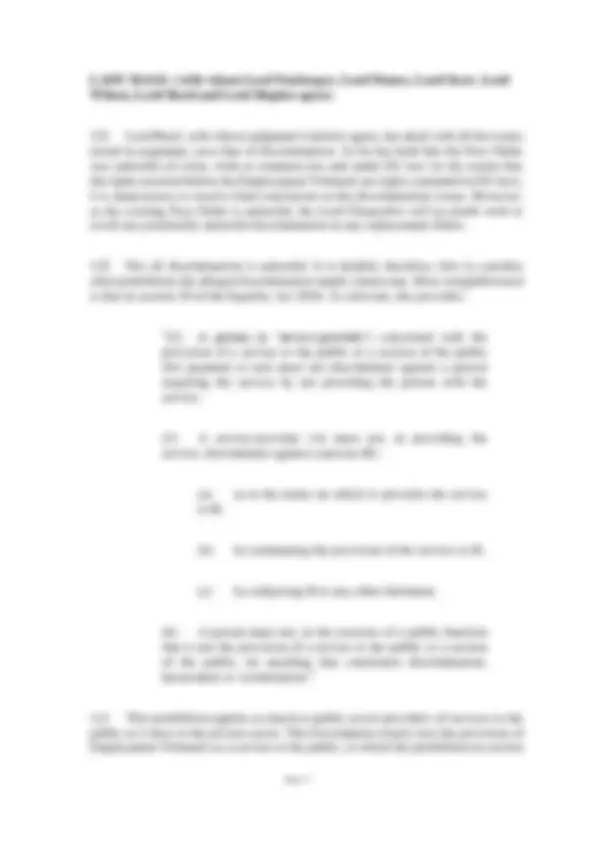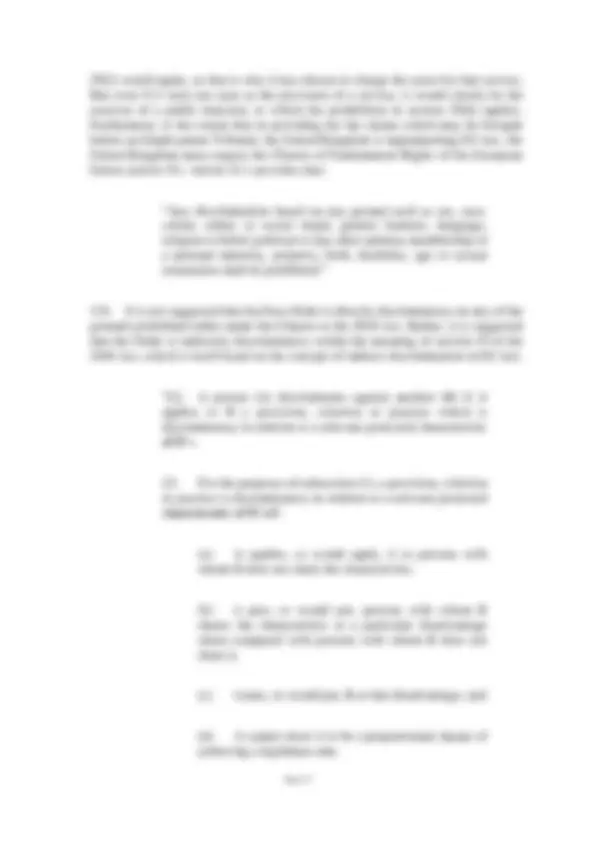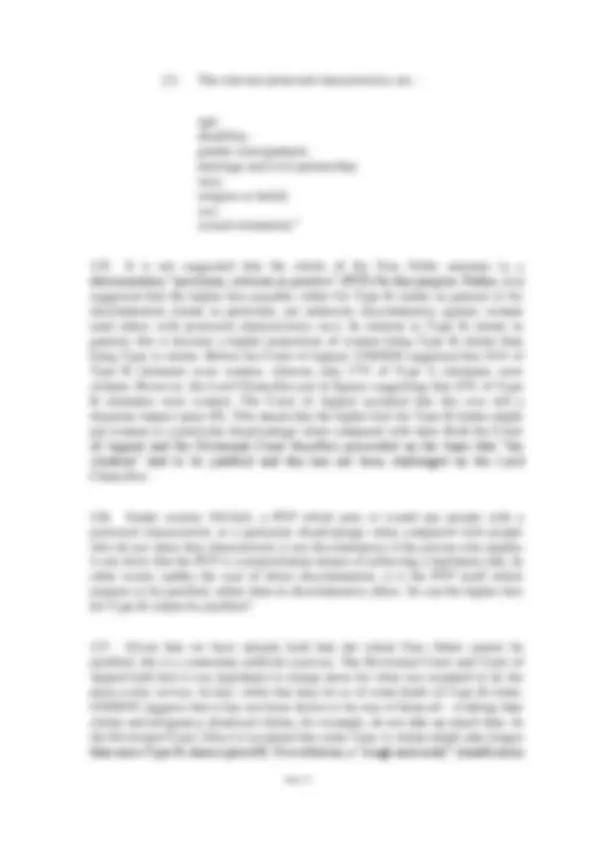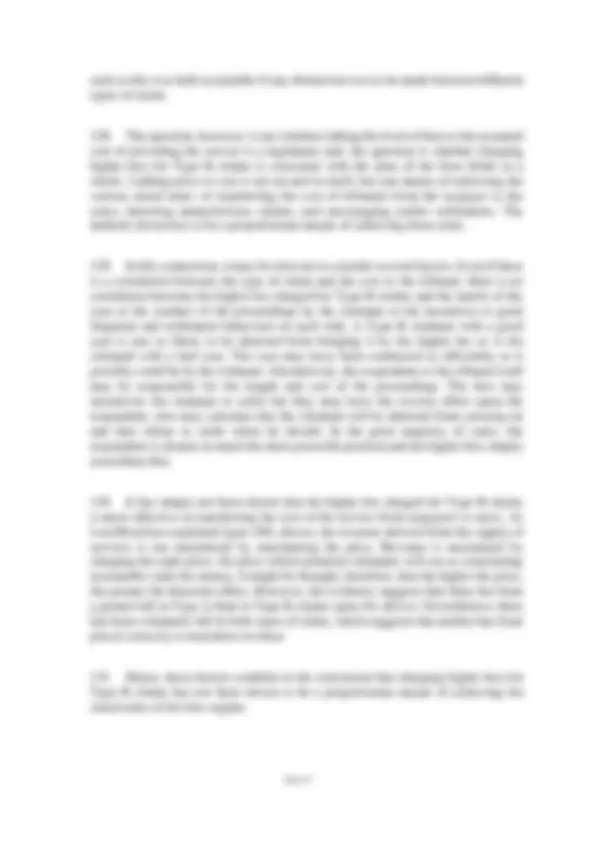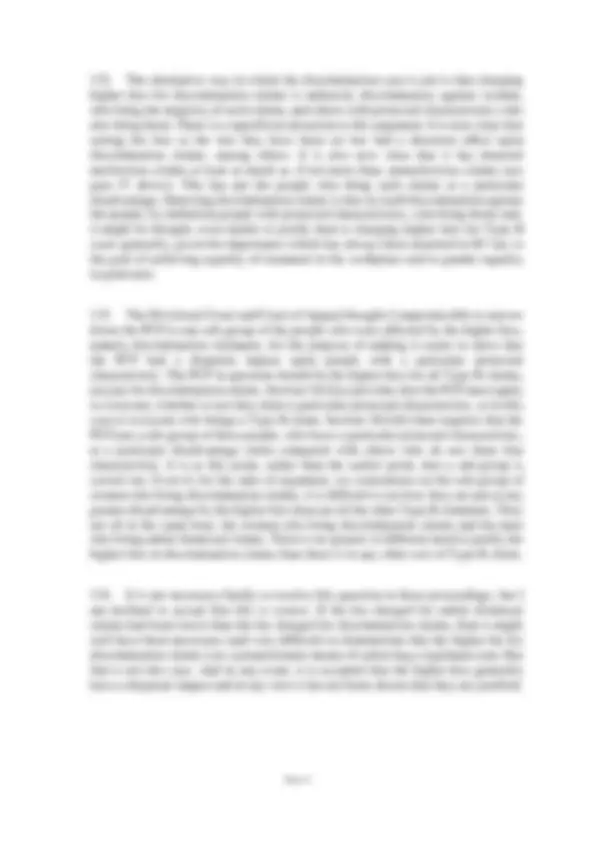Download ET Fees & Access to Justice: Analyzing Discriminatory Impact on Type B & Discrimination Cl and more Study notes Human Rights in PDF only on Docsity!
Trinity Term [2017] UKSC 51 On appeal from: [2015] EWCA Civ 935
JUDGMENT
R (on the application of UNISON) (Appellant) v
Lord Chancellor (Respondent)
before
Lord Neuberger, President
Lady Hale, Deputy President
Lord Mance
Lord Kerr
Lord Wilson
Lord Reed
Lord Hughes
JUDGMENT GIVEN ON
26 July 2017
Heard on 27 and 28 March 2017
Appellant Respondent Dinah Rose QC David Barr QC Karon Monaghan QC Victoria Wakefield Iain Steele Matthew Purchase (Instructed by UNISON Legal Services) (Instructed by The Government Legal Department) Intervener (1) Michael Ford QC Mark Whitcombe Spencer Keen (Instructed by Equality and Human Rights Commission) Intervener (2) (Written submissions only) Aidan O’Neill QC (Instructed by Balfour & Manson) (1) Equality and Human Rights Commission (2) Independent Workers Union of Great Britain
The background to the Fees Order
- Relationships between employers and employees are generally characterised by an imbalance of economic power. Recognising the vulnerability of employees to exploitation, discrimination, and other undesirable practices, and the social problems which can result, Parliament has long intervened in those relationships so as to confer statutory rights on employees, rather than leaving their rights to be determined by freedom of contract. In more recent times, further measures have also been adopted under legislation giving effect to EU law. In order for the rights conferred on employees to be effective, and to achieve the social benefits which Parliament intended, they must be enforceable in practice.
- In 1968 the Donovan Report (the Report of the Royal Commission on Trade Unions and Employers’ Associations, Cmnd 3623) recommended that labour tribunals should be established to provide “an easily accessible, speedy, informal and inexpensive procedure” for the settlement of employment disputes (para 578). As a result, the jurisdiction of industrial tribunals, originally established by the Industrial Training Act 1964 to hear appeals concerning training levies, was extended to include jurisdiction over a wide range of employment rights. In 1998, they were renamed employment tribunals.
- ETs are intended to provide a forum for the enforcement of employment rights by employees and workers, including the low paid, those who have recently lost their jobs, and those who are vulnerable to long term unemployment. They are designed to deal with issues which are often of modest financial value, or of no financial value at all, but are nonetheless of social importance. Their procedural rules, which include short limitation periods and generous rights of audience, reflect that intention. It is also reflected in the fact that, unlike claims in the ordinary courts, claims in ETs could until recently be presented without the payment of any fee. The Leggatt Report (the Report of the Review of Tribunals, 2001) identified the absence of fees as one of the three elements which had rendered ETs successful.
- In January 2011 the Government published a paper entitled Resolving Workplace Disputes: A Consultation , in which it announced its intention to introduce fee-charging into ETs and the EAT. Charging fees was considered to be desirable for three reasons. First, and most importantly, fees would help to transfer some of the cost burden from general taxpayers to those that used the system, or caused the system to be used. Secondly, a price mechanism could incentivise earlier settlements. Thirdly, it could dis-incentivise unreasonable behaviour, such as pursuing weak or vexatious claims.
- Detailed proposals were published in December 2011 in a consultation paper issued by the Ministry of Justice entitled Charging Fees in the Employment Tribunals and the Employment Appeal Tribunal. Two alternative options for ETs were discussed, one of which went on to form the basis of the system set out in the Fees Order. The option which was ultimately preferred (Option 1) based the fee on the subject-matter of the claim (since the level of tribunal resources used generally depends on the complexity of the issues raised by the claim) and on the number of claimants (since claims brought by two or more people that arise from the same circumstances are processed together as multiple claims). It was proposed that an “issue fee” should be paid at the time of lodging the claim, and that a further “hearing fee” should be paid in advance of a final hearing.
- The paper explained that the main purpose of a fee structure was to transfer part of the cost burden from the taxpayer to the users of the service, since a significant majority of the population would never use ETs but all taxpayers were being asked to provide financial support for this service. However, fees must not prevent claims from being brought by making it unaffordable for those with limited means. A fee remission system would therefore be a key component of the fee structure. The other issues taken into account were the importance of having a fee structure which was simple to understand and administer, and the importance of encouraging parties to think more carefully about alternative options before making a claim.
- The paper noted that the impact of fees on the number of claims was difficult to forecast, in the absence of research concerned specifically with ET users. Research into the impact of fee-charging in the civil courts suggested that tribunal users required to pay a fee would not be especially price sensitive. The charging of fees in two stages, at the commencement of the proceedings and prior to a final hearing, was intended to reflect the cost of the services provided at each stage, and to encourage users to consider settlement during as well as before the tribunal process.
- An impact assessment was published in May 2012. It concluded that it was not possible to predict how claimants would respond to the introduction of fee- charging. Two alternative assumptions were therefore made for modelling purposes. On the low response scenario, demand was assumed to decrease by 1% for every £100 of fee. On the high response scenario, demand was assumed to decrease by 5% for every £100 of fee. The methodology was then to place an economic value on the costs and benefits of implementing Option 1. One of the non-monetised benefits was identified as being “reduced ‘deadweight loss’ to society as consumption of ET/EAT services is currently higher than would be the case under full cost recovery”. In that regard, the analysis proceeded on the basis that the consumption of ET and EAT services without full cost recovery resulted in a “deadweight loss” to society. As was stated:
fees for a single claimant total £1,200, comprising an issue fee of £250 and a hearing fee of £950. The fees payable by groups vary according to the type of claim and the number of claimants in the group. For the smallest groups, of between two and ten claimants, the fees total £780 for type A claims and £2,400 for type B claims. For the largest groups, of over 200 claimants, the fees total £2,340 for type A claims and £7,200 for type B claims. Counsel for the Lord Chancellor were unable to explain how any of the fees had been arrived at.
- In the EAT, fees of £1,600 are payable, again in two stages: £400 on the date specified in a notice issued by the Lord Chancellor following the EAT’s receipt of a notice of appeal, and £1,200 on the date specified in a notice issued by the Lord Chancellor following a direction by the EAT that a matter proceed to a final oral hearing. There is no distinction between different types of appeal or between single and group appellants. Comparison with court fees
- Many claims which can be brought in ETs are for modest financial amounts. The fee structure is however very different from that applied to small claims in the County Court. ET fees for single claimants are set at one of two fixed rates: £ for type A claims, and £1,200 for type B claims. The difference reflects the tribunal time which the claims are expected to require, and therefore has the effect of penalising claimants according to the complexity of their claims. Although most claims of a kind attracting low monetary awards tend to be classified as type A, the fees prescribed by the Fees Order bear no direct relation to the amount sought, and can therefore be expected to act as a deterrent to claims for small amounts and non- monetary claims. In the County Court, on the other hand, fees for small claims are graduated according to the value of the claim. For claims issued online, they begin at £50 for claims up to £300, and rise in stages to £745 for claims between £5, and £10,000. The fee structure has thus been designed in a way which is likely to have a less deterrent effect on the bringing of small claims. There is also no penalty for bringing a complex claim rather than a simple one. It is only once a claim exceeds £3,000 that the fees payable in the County Court exceed the ET fees for a type A claim. Even the highest fees in the County Court for small claims are well below the ET fees for type B claims. Remission
- Article 17 of the Fees Order makes provision for the remission of fees in accordance with Schedule 3. As substituted by the Courts and Tribunals Fee Remissions Order 2013 (SI 2013/2302), with effect from 7 October 2013, Schedule 3 provides that claimants and appellants are not entitled to remission unless they
satisfy “the disposable capital test”: that is to say, their disposable capital must be less than a specified amount, which varies according to the amount of the fee. “Disposable capital” is the value of every resource of a capital nature belonging to the party on the date on which the application for remission is made, subject to certain exclusions. For these purposes, the disposable capital of a claimant’s partner is treated as the claimant’s disposable capital, unless the partner has a contrary interest in the matter to which the fee relates. In respect of any fee up to and including £1,000 (which includes all the fees payable by single claimants, except for the £1,200 hearing fee in the EAT), no remission is available if the claimant is treated as having £3,000 or more in disposable capital. There is no explanation of how that figure, or any of the other figures relating to remission, were arrived at. Where the fee is between £1,001 and £1,335 (including the EAT hearing fee of £1,200), no remission is available if the claimant is treated as having disposable capital of £4,000 or more. Thus, if a claimant and his or her partner have savings of £3,000, the claimant will have to pay the full £390 for a type A claim in the ET and the full £1,200 for a type B claim, regardless of their income. It has to be borne in mind that some potential claimants may have temporarily inflated capital balances, due for example to payments received on the termination of their employment or to savings made in anticipation of childbirth. So, for example, if a woman has been selected for redundancy on a discriminatory basis, she will be disqualified from receiving any remission in proceedings to challenge the discrimination if the redundancy payment amounts to £3,000 or more.
- If the disposable capital test is satisfied, then the amount of any remission is calculated by applying “the gross monthly income test”. To qualify for full remission, the gross monthly income (which includes any partner’s income as well as the claimant’s own, unless they have contrary interests in relation to the matter in dispute) must be below a specified amount, which varies depending on whether the claimant is single and whether he or she has children. The specified amount for a single person without children is £1,085 per month. That figure rises by £245 per month for each child. The specified amount for a couple without children is £1, per month. That figure also rises by £245 per month for each child. For example, for a couple with two children, the specified amount is £1,735 per month.
- Partial remission is available on the basis that, for every £10 of gross monthly income above the specified amount, the claimant must pay £5 towards the fee. For example, a claimant with a partner and no children has to pay a full issue fee for a type A claim once her and her partner’s gross monthly income exceeds £1,565, and a full hearing fee once it exceeds £1,705. A couple with two children have to pay the full issue fee for a type A claim once their gross monthly income exceeds £2,055, and the full hearing fee once their gross monthly income exceeds £2,195. So far as type B claims are concerned, a claimant with a partner and no children has to pay the full issue fee once her and her partner’s gross monthly income exceeds £1,745, and the full hearing fee once their gross monthly income exceeds £3,145.
abusively, disruptively or otherwise unreasonably in either bringing or conducting the proceedings. The rules of procedure of the ET and the EAT were however amended, when the Fees Order came into force, so as to give them a discretionary power to make an order that one party should pay the other the amount of any fees paid under the Order. A series of decisions in the EAT have held that such an order should normally be made in favour of a successful party, although it will not be appropriate in every case (for example, where their success was only partial, or where the respondent is unable to pay the sums in question).
- Although it is therefore possible to recover fees in the event that a claim is successful, it is necessary to bear in mind that it is generally difficult to predict with confidence that a claim will succeed. That is so for a number of reasons. One is that estimating prospects of success is not an exact science, especially before proceedings have been initiated. Depending on the nature of the case, initial estimates can often change during the course of proceedings as new information comes to light. In that regard, it is relevant to note that the pre-claim questionnaire procedure, under which an employer could be required to provide an explanation for a difference in treatment in advance of a claim being issued, was abolished in 2013. Secondly, a reliable estimate depends on legal judgment and experience, which may not be available to an employee contemplating bringing a claim in an ET: employment disputes generally fall outside the scope of legal aid. Thirdly, employment law is characterised by a relatively high level of complexity and technicality. It is also important to bear in mind that, even if an order is made for the reimbursement of fees, there is a significant possibility that the order will not be obeyed. This will be discussed shortly.
- More fundamentally, the right of access to justice, both under domestic law and under EU law, is not restricted to the ability to bring claims which are successful. Many people, even if their claims ultimately fail, nevertheless have arguable claims which they have a right to present for adjudication. The claims brought before ETs
- The majority of successful ET claims result in modest financial awards. For example, it appears from statistics published by the Ministry of Justice that in 2012/13 (pre-fees), 34% of successful race discrimination claims resulted in awards of less than £3,000. 52% resulted in awards of less than £5,000. The corresponding figures for religious discrimination claims, and claims of unfair dismissal, were similar.
- Some types of claim generally result in much lower awards. Statistics published by the Department for Business, Innovation and Skills in June 2014
indicated, for example, that the median award in successful claims for unlawful deductions from wages in 2013 was £900, and that 25% of successful claimants were awarded less than £500 (Findings from the Survey of Employment Tribunal Applications, Research Series No 177). Some claims are for even smaller amounts: for example, claims for time off for ante-natal care under sections 55-57 of the Employment Rights Act 1996 (implementing Directive 92/85/EEC), where the award is the amount of remuneration to which the employee would have been entitled had she been granted the time off; claims for a statement of reasons for dismissal, under sections 92 and 93 of the 1996 Act, where the award is of two weeks’ pay; and claims for unauthorised deductions of trade union subscriptions under sections 68 and 68A of the Trade Union and Labour Relations (Consolidation) Act 1992, where the award is the amount deducted. Leaving aside claims for unfair dismissal, breach of contract, unlawful deductions from wages, redundancy pay and discrimination, the median award in all other types of claim in 2013 was £1,000.
- Some important types of claim before ETs do not involve monetary awards. An example is a claim for a written statement of particulars of employment. The particulars set out important information about such matters as working time, pay and holidays, which is vital to the enforcement of other employment rights. Employers are required to provide employees with such particulars by section 1 of the Employment Rights Act 1996. Where an employer fails to provide a statement, or there is a question as to whether all the necessary particulars have been included, the employee is entitled to refer the matter to an ET under section 11. These provisions give effect to Directive 91/533/EEC. Article 2 of the Directive imposes an obligation to provide the particulars, and article 8 provides: “1. Member states shall introduce into their national legal systems such measures as are necessary to enable all employees who consider themselves wronged by failure to comply with the obligations arising from this Directive to pursue their claims by judicial process after possible recourse to other competent authorities.” As the words “consider themselves wronged” make clear, the obligation imposed by article 8 is not confined to employees whose claims turn out to be well-founded. A reference of this kind is classified as a type A claim.
- Some other claims in which no compensation is payable are classified as type B, with the consequence that fees of £1,200 are payable in order to proceed to a hearing. An example is the right of fixed-term workers to obtain a declaration that they are permanent employees, under regulation 9(5) of the Fixed-Term Employees (Prevention of Less Favourable Treatment) Regulations 2002 (SI 2002/2034),
The effect of the Fees Order (i) Impact on the number of claims
- Information about the effect of the Fees Order on the number of claims can be derived from two sources. The first, relied on by the appellant, comprises the tribunal statistics published by the Ministry of Justice under the title Tribunals and Gender Recognition Certificate Statistics Quarterly. The court was referred to the statistics published in December 2016, which were not available to the courts below. The second source, relied on by the Lord Chancellor, is a consultation paper published by the Ministry of Justice in January 2017, entitled Review of the introduction of fees in the Employment Tribunals: Consultation on proposals for reform (Cm 9373) (“the Review Report”). It too was not available to the courts below. Both sources present a similar picture, although the figures are slightly different (those in the Review Report are not taken from the Ministry’s published tribunal statistics, but are based on “HMCTS management information” for different periods).
- Although there are differences between the figures given in the different sources, the general picture is plain. Since the Fees Order came into force on 29 July 2013 there has been a dramatic and persistent fall in the number of claims brought in ETs. Comparing the figures preceding the introduction of fees with more recent periods, there has been a long-term reduction in claims accepted by ETs of the order of 66-70%. The Review Report considered possible explanations, besides the introduction of the fees, and suggested that improvements in the economy would have been expected to result in a fall in single claims of about 8%. It concluded: “The actual fall since fees were introduced has been much greater and we have therefore concluded that it is clear that there has been a sharp, substantial and sustained fall in the volume of case receipts as a result of the introduction of fees.” (para 105) The Report concluded that “the overall scale of the fall ... is troubling” (para 336). (ii) Impact on the value of claims
- The Review Report referred to evidence submitted by the Council of Employment Judges, and by the Presidents of the ETs, that there had been a greater fall in lower value claims, such as claims for unpaid wages and unpaid annual leave, and in claims in which a financial remedy was not sought, such as claims to
entitlement to breaks. They argued that this suggested that, at least for some types of case, the fees were disproportionate to what was at stake in the proceedings, and people were deciding that they were not economically worthwhile. The Review also reported a greater fall in type A claims, which tend to be of lower value, than in type B claims.
- These findings are consistent with research published by the Department for Business, Innovation and Skills prior to the introduction of fees (“Findings from the Survey of Employment Tribunal Applications 2008”, 2010), which found in surveys that those whose decision whether to bring an ET claim was most likely to be influenced by the payment of a £250 fee included the low paid (whose claims tend to be less valuable in so far as awards are related to earnings), and those with claims for unlawful deductions from wages (which, as explained earlier, tend to be for modest amounts).
- According to the published tribunal statistics, the proportion of successful claims receiving low awards has markedly decreased. For example, the proportion of successful race discrimination claims resulting in awards of less than £3,000 is recorded as having fallen from 34% in 2012/13 to 8% in 2015/16. For awards of less than £5,000, the fall was from 52% to 19%. There were corresponding falls (some larger in amount, some smaller) for all other categories of discrimination claim, and also for unfair dismissal claims. This change is also reflected in a marked rise in median awards in all categories of discrimination claim, and also in unfair dismissal claims. For example, the median award in race discrimination claims is reported to have risen over the same period from £4,831 to £13,760. (iii) The impact of remission
- The impact assessment published in May 2012 estimated that at least 24% of the pre-fees population of claimants would receive full remission, and that a further 53% would receive partial remission on fees up to £950. In the event, the Review Report found that the proportion of the post-fees population of claimants receiving full or partial remission was initially very low, but had increased by 2016 to about 29%. The proportion of claimants receiving remission is therefore far lower than had been anticipated. The actual number is even lower, compared with what had been anticipated, given the difference between the number of claimants before and after the introduction of fees.
- So far as concerns the Lord Chancellor’s discretionary power to remit fees in exceptional circumstances, in practice this power to remit has rarely been exercised. It was exercised 31 times during the period between 1 July 2015 and 30 June 2016:
In relation to the second and third suggestions, as explained earlier, the remission scheme is of very limited scope except in relation to type B hearing fees, and the Lord Chancellor’s power to remit in exceptional circumstances is exercised only in cases of exceptional hardship.
- More fundamentally, the implicit premise of all three suggestions is that anyone who does not qualify for full remission will, in all but exceptional cases (which can be addressed by the discretion to remit in exceptional circumstances), have non-essential income or capital which can be used to pay the fees. It is on that basis that the Lord Chancellor argues that legal requirements as to access to justice are satisfied. It will be necessary to return to these issues. (v) Hypothetical claimants
- In addition to the tribunal statistics, the Review Report and the Acas research, the appellant has also produced details of the effect of the fees on a number of hypothetical claimants in low to middle income households. Two examples may be given.
- The first hypothetical claimant is a single mother with one child, working full-time as a secretary in a university. She has a gross income from all sources of £27,264 per annum. Her liability to any issue or hearing fee is capped under the remission scheme at £470 per fee. She therefore has to pay the full fees (£390) in order to pursue a type A claim to a hearing, and fees totalling £720 in order to pursue a type B claim. The net monthly income which she requires in order to achieve acceptable living standards for herself and her child, as assessed by the Joseph Rowntree Foundation in its report, Minimum Income Standards for the UK in 2013 , is £2,273: an amount which exceeds her actual net monthly income of £2,041. On that footing, in order to pursue a claim she has to suffer a substantial shortfall from what she needs in order to provide an acceptable living standard for herself and her child.
- The Lord Chancellor disputes the use made of the Joseph Rowntree Foundation’s minimum income standards. On the Lord Chancellor’s approach, no provision should be made for any expenditure on clothing (for which £10 per week had been allowed), personal goods and services (£12 per week), social and cultural participation (£48 per week), or alcohol (£5 per week), on the basis that all spending of these kinds can be stopped for a period of time in order to save the amount required to bring a claim. On that basis, the amount of the claimant’s net monthly income, after minimum living standards are met, is £202 per month. In order to meet the fees, she therefore has to sacrifice all other spending, beyond the matters accepted by the Lord Chancellor to be necessities, for a period of two months, in
order to bring a type A claim, and for three and a half months, in order to bring a type B claim.
- The second hypothetical claimant has a partner and two children. She and her partner both work full-time and are paid the national minimum wage. They have a gross income, when benefits and tax credits are also taken into account, of £33, per annum. The claimant’s liability to fees is capped under the remission scheme at £520. She therefore has to pay the full fees of £390 in order to pursue a type A claim, and fees totalling £770 in order to bring a type B claim. The net monthly income the family require in order to achieve an acceptable living standard, as assessed by the Joseph Rowntree Foundation, is £3,097: an amount which exceeds their actual net monthly income of £ 2 ,866. They therefore have to make further inroads into living standards which are already below an acceptable level if a claim is to be brought.
- On the Lord Chancellor’s approach, the family have a net monthly income available, after excluding all expenditure on clothing, personal goods and services and so forth, of £593 per month. On that basis, a claim can be brought if spending is restricted to items accepted by the Lord Chancellor to be necessities for a period of about a month.
- One problem with the Lord Chancellor’s approach to these calculations is that some of the expenditure which he excludes, such as spending on clothing, may not in fact be saved, but is simply postponed. For example, if the children need new clothes because they have outgrown their old ones, replacements have to be purchased sooner or later. The impact of the fees on the family’s ability to enjoy acceptable living standards is not avoided merely by postponing necessary expenditure. A second problem is that claimants may not have prolonged periods of time available to them during which to save the amount required to pay the fees. Claimants are expected to bring their claims promptly, in keeping with the intention that the process should be speedy. The usual time limit for bringing a claim in the ET is three months, starting from the date of the event giving rise to the claim. The issue fee must be paid then, although more time is available before the hearing fee will be due. More fundamentally, the question arises whether the sacrifice of ordinary and reasonable expenditure can properly be the price of access to one’s rights. (vi) Transferring the cost burden to users of the tribunals
- As explained earlier, the principal aim of the introduction of fees was to transfer part of the cost burden of the tribunals from taxpayers to users of their services. The Review Report states:
- According to the tribunal statistics, in 2011/12 33% of claims were settled through Acas. The following year, the proportion was again 33%. In 2014/15, following the introduction of fees, 8% of claims settled through Acas. In 2015/16, the figure rose again to 31%. Even ignoring the exceptional figure for 2014/15, it appears that the proportion of cases settled through Acas has slightly decreased since fees were introduced. That is consistent with the view of commentators, noted in the Review Report, that some employers were delaying negotiations to see whether the claimant would be prepared to pay the fee. The history of the proceedings
- On 28 June 2013 the appellant issued a claim for judicial review (“the First JR”) in which it sought to have the Fees Order quashed on the grounds that it breached the EU principles of effectiveness and equivalence, was brought into force in breach of the Public Sector Equality Duty imposed by the Equality Act 2010, and was indirectly discriminatory. The Divisional Court (Moses LJ and Irwin J) dismissed the claim, holding that the proceedings were premature and that the evidence was insufficiently robust to sustain the grounds of challenge: [2014] EWHC 218 (Admin); [2014] ICR 498.
- The appellant was initially granted permission to appeal only on the effectiveness ground and to adduce fresh evidence showing the fall in the number of ET claims instituted. The appellant renewed its application for permission on the remaining grounds of challenge, and the respondent applied to set aside the order in so far as it granted permission to adduce fresh evidence. These applications were adjourned by consent to permit fresh judicial review proceedings to be commenced, taking into account the new evidence.
- On 23 September 2014 the appellant issued a second claim for judicial review (“the Second JR”) in which it sought to have the Fees Order quashed on two grounds, namely the effectiveness ground and the discrimination ground. The Divisional Court (Elias LJ and Foskett J) dismissed the claim: [2014] EWHC 4198 (Admin); [2015] ICR 390, citing with approval the conclusion in the First JR that the principle of effectiveness was not violated unless the fees were so high that the prospective litigant was clearly unable to pay them. It granted permission to appeal on both grounds of challenge. The Court of Appeal subsequently gave permission to appeal on the remaining grounds in the First JR, and the two appeals were joined. In the event, the equivalence ground in the First JR was not pursued.
- The Court of Appeal (Moore-Bick, Davis and Underhill LJJ) dismissed the appeals: [2015] EWCA Civ 935; [2016] ICR 1. Underhill LJ, with whose judgment Moore-Bick and Davis LJJ agreed, considered that the imposition of a fee would not
constitute an interference with the right of effective access to a tribunal under EU law unless it made it impossible in practice to access the tribunal. That depended on whether the fee was unaffordable (para 41), and not on whether the payment of the fee would be a sensible use of money (para 45). In applying the affordability test to the evidence, Underhill LJ saw no safe basis for “an inference that the decline [in the number of claims] cannot consist entirely of cases where potential claimants could realistically have afforded to bring proceedings but have made a choice not to” (para 68: emphasis in the original). Only evidence of the actual affordability of the fees in the financial circumstances of typical individuals could enable the court to reach a reliable conclusion that the fees were realistically unaffordable in some cases (ibid). Underhill LJ also rejected the arguments based on the Public Sector Equality Duty and the discrimination ground.
- The issue concerning the effect of the Fees Order on access to justice was argued before the courts below on the basis of EU law, although some domestic authorities and judgments of the European Court of Human Rights were also cited. Before this court, it has been recognised that the right of access to justice is not an idea recently imported from the continent of Europe, but has long been deeply embedded in our constitutional law. The case has therefore been argued primarily on the basis of the common law right of access to justice, although arguments have also been presented on the basis of EU law and the European Convention on Human Rights. The appellant has also argued the discrimination ground, and has been permitted to advance a new ground of challenge, namely that the Fees Order is ultra vires because it frustrates the operation of a variety of statutory provisions. The argument advanced below on the basis of the Public Sector Equality Duty has not been pursued. Is the Fees Order unlawful under English law?
- In determining the extent of the power conferred on the Lord Chancellor by section 42(1) of the 2007 Act, the court must consider not only the text of that provision, but also the constitutional principles which underlie the text, and the principles of statutory interpretation which give effect to those principles. In that regard, there are two principles which are of particular importance in this case. One is the constitutional right of access to justice: that is to say, access to the courts (and tribunals: R v Secretary of State for the Home Department, Ex p Saleem [2001] 1 WLR 443). The other is the rule that “specific statutory rights are not to be cut down by subordinate legislation passed under the vires of a different Act” ( R v Secretary of State for Social Security, Ex p Joint Council for the Welfare of Immigrants [1997] 1 WLR 275, 290 per Simon Brown LJ). In the context of the present case, there is a considerable degree of overlap between these two principles. For the sake of clarity, however, each of these principles will be considered in turn.


